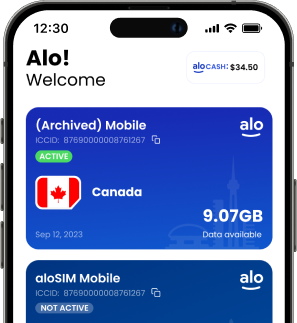Traveling soon? A data eSIM will keep your phone connected to the internet without roaming charges.
If you’ve never tried one, today we’re going to explain what it is, how you get one, how much it costs, and why it’s a life-changing travel hack for your next trip.
What is a data eSIM?
A data eSIM is a virtual SIM card living inside your device. It lets your device connect to networks in other countries so you can have easy, inexpensive mobile data without messing around with physical SIM cards.
These hardworking eSIMs can be used at home or while traveling, but they’re mostly used for travel because they give people access to affordable local travel data.
With data packages as small as 1 GB, travelers can add small amounts of mobile data to their devices without contracts or commitments. If they need more data, it’s easy to top up.
Why you should use a data eSIM
There are a couple of solid reasons to use a data eSIM:
1. You’re traveling. Use your phone freely and stay connected, all without roaming charges.
2. You need temporary data. Use a data eSIM to add short-term data to a device that doesn’t normally have it (like an old phone, or your kids’ phones).
3. You want contract-free data. If you don’t want to pay $50 a month for data you won’t really use, an eSIM is a great way to add a bit of data whenever you want it, on your own terms.
No roaming charges, seriously? How?
It sounds like magic, doesn’t it? But the truth is that a data eSIM can absolutely prevent you from paying roaming charges.
What are roaming charges? Well, they’re the fees your home carrier will make you pay if you let your device “roam” (a.k.a. connect to other networks outside your usual coverage zone). Even the tiniest online actions (receiving an email, checking a map, letting a social media app run in the background) all require mobile data, or an internet connection. So roaming charges can add up quickly, leaving you with a painful mobile bill to pay.
But when you refuse to let your phone “roam” (by turning Data Roaming “off”), your home carrier can’t charge you for roaming. Zero dollars, zero cents. Absolutely no roaming fees.
Some people might just be content to let their phone stay “disconnected” for most of their trip, and occasionally use a free Wi-Fi connection if they can find it. They’d be able to play online games and check social media, but their phone number would not work — phones need networks — until they were back at home, and their phone could latch onto its regular network.
People who prefer to stay connected — without paying roaming charges — keep Data Roaming “off” for their primary plan, but use an inexpensive data eSIM to maintain a data connection while traveling. They like being able to use their phone for everything they’d normally do — email, texting, calling, maps, online games, social media, etc. — without needing to hunt down a Wi-Fi network.
How is this different from carrier travel data?
A data eSIM gives your phone the ability to connect to local networks in different countries, regardless of your usual phone carrier. When you hook onto these networks, you’re essentially using your phone as if you were a local citizen. That’s why eSIM prices are so inexpensive. eSIM data also gives you the flexibility to pre-pay for small amounts of data, with the freedom to top up your eSIM if you need more.
When you use a carrier travel data plan, you’re making a deal with your home carrier that you will let them connect you to their partner networks in a new location, outside of your normal coverage zone. They usually charge a lot for this service, because it’s more expensive for them to keep you connected in another country (potentially on the other side of the world). Carrier travel data plans are often one-size-fits-all, where you pay a steep daily fee whether or not you use much data.
Because a data eSIM is so much cheaper (and more flexible) than a carrier travel data, most travelers prefer to rely on an eSIM to stay connected on their travels.
Can my phone support a data eSIM?
Great question! Not every phone or tablet can support a data eSIM, but many newer models do.
We maintain an up-to-date list of the devices that are eSIM compatible. So if you’re new to eSIM, check the list and make sure you have a device that can support a data eSIM.
Who sells data eSIMs?
You can buy a data eSIM from any eSIM provider, but of course we hope you’ll consider purchasing a data eSIM from our team here at aloSIM. 😉
Our free aloSIM app is available in the App Store and Google Play. Just download it and search for the area where you need a data eSIM!
How much does a data eSIM cost?
The cost of a data eSIM depends on how expensive data is in a particular country or region.
In some countries, data is cheap and plentiful, so eSIM packages are cheap, too. In areas where the infrastructure is shakier and it’s more expensive to get a connection, you’ll see higher prices for eSIM data.
The price of a data eSIM also depends on how much data you’d like to buy. A 1 GB data package that will work for seven days is going to be cheaper than a 10 GB package that will work over 30 days.
So what size data package should you buy? Well, it depends on how much travel data you think you’ll need. If you think you’ll have access to Wi-Fi for a good chunk of your vacation, feel free to just start with a little 1 GB data package and see how it goes. That might be plenty of data to last you for a full week.
But if you know you’ll go through quite a lot of data on a trip, you’ll save money by purchasing a larger package from the get-go. (Like how it’s cheaper to purchase something in bulk.) For example, if a 1 GB data package is $5 but a 5 GB data package is $15, you’ll get a better deal purchasing the 5 GB package — which works out to just $3 per GB.
(No guessing games with us! Here at aloSIM, you can browse all of our prices online to see exactly what you would pay for a data eSIM in 120+ countries.)
Where can I use a data eSIM?
If you buy a data eSIM from aloSIM, we have them available for 120+ countries. We also have eSIMs that will work in entire regions of multiple countries, if you’ll be doing a lot of touring around. Your eSIM will work within the country (or region) that you purchase, but it won’t work in other areas.
For example, if you live in the United States but purchase an eSIM for a trip to France, that eSIM will only connect you to supported networks within France. The eSIM itself contains the ability to connect to specific networks.
How do I make phone calls with a data eSIM?
A data eSIM doesn’t include its own phone number, but don’t worry — you can still make and receive phone calls while relying on an eSIM for mobile data.
One option is to use a third-party calling app. We make a great one called Hushed, where you can buy cheap phone numbers for calling/texting and keep them as long as you want. The Hushed app works perfectly on Wi-Fi or mobile data, since these phone numbers run over the internet and not through traditional phone lines.
Another option is to use a social media platform for calling using an eSIM. Try Messenger or Instagram.
But many travelers prefer to make and receive phone calls on their primary phone line. After all, that’s the phone number everybody already knows to dial, and it’s the phone number associated with all of your contacts. Not to mention, it’s what people will call if there’s an emergency back home.
And you might think “Yikes! Of course I can’t use my regular phone number while I’m traveling. I did that once, and paid a ton of money in roaming charges. Never again!”
But when most people use their regular phone number while traveling, they’re also letting their phone “roam” and automatically relying on their home carrier for mobile data … and that, my friends, is the hideously expensive part! The roaming to get that data connection, not the actual calls and texts. *lightbulb moment*
So if you’re using an eSIM for that data connection, you’re golden. Keep Data Roaming “off” on your primary phone line, so your home carrier can’t charge you a cent for data roaming.
But you can still leave your regular phone line “on,” so it’s working. Your eSIM will provide the data you need to keep it connected, and your carrier can only charge you small fees for individual calling minutes/texts. We always recommend you chat with them before your trip, to check how much you’ll pay for calls/texts while traveling.
You can explain that you’ll be using a data eSIM for data — so you have that covered, and no, you don’t need a carrier travel data plan — but you want to know what you’ll be charged for calls and texts while outside your normal coverage zone.
Can I text with it?
Since a data eSIM doesn’t come with its own phone number, you can text using a third-party app (like our sister app, Hushed, which specializes in temporary phone numbers for calling and texting).
Or you can leave your regular SIM “on” so you can call and text on your regular phone number. Just be sure Data Roaming is “off” for that SIM, so you don’t incur roaming charges.
Again, please speak with your carrier before heading off on your trip to see what they might charge for individuals calling minutes/texts.
A sample script would be “Hi! I’m traveling to *countryname* next week, and I’ll be using a data eSIM so I don’t incur roaming charges. But I’d like to know how much I’ll be charged for calling/texting while I’m away. Could you please tell me what those rates would be?”
What if I don’t want my regular phone line on?
If you don’t want your regular phone line on — maybe because you’re not interested in calling/texting while you’re away — that’s no problem at all.
It takes two seconds to switch that SIM “off” in your device’s settings. It’s the equivalent of removing the SIM card entirely, but your SIM gets to stay safely inside your device so it can’t be lost or damaged.
How to install a data eSIM
A data eSIM is easy to install. Here at aloSIM, we walk you through every step of the eSIM installation process using our free mobile app. Once your eSIM is installed, you can use it for the length of your first data plan (i.e. 7 days, 10 days, 30 days) or you can keep it and continue to top it up later on.
When do I activate my eSIM?
If you’re going to be traveling, we recommend you install your new eSIM a day or two before leaving on your trip. That way you can make sure you have a solid internet connection to download and install everything, without an interruption in the process. (Waiting until you’re in the Customs line at the airport can be dodgy.)
However, please wait until you’ve arrived at your destination to activate your eSIM so you can start using your new data.
There’s no point to activating it before you arrive, since you won’t be able to connect to a Mexico network until you’re actually in Mexico, for example. You’ll just be wasting precious days of your data package, as the countdown to eSIM expiration begins once it’s activated.
Fast facts: Data eSIM
* A data eSIM can provide compatible devices with low-cost mobile data (i.e. an internet connection)
* A data eSIM does not include a phone number, but you can still make/receive phone calls and send/receive texts
* A data eSIM is a great way to keep your device connected on a trip, without paying roaming charges
* eSIM providers like aloSIM have data eSIMs starting as low as $4.50, and available for 120+ countries
Still have questions about data eSIMs? We’re here to help! Please reach out to our Support team anytime.





